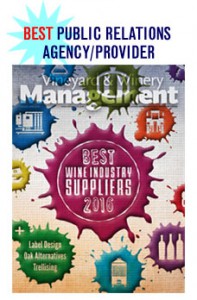One of the most important books to be published recently in the wine world is Kelli White’s Napa Valley Then & Now. We recommend acquiring a copy (you can do so here); it’s truly a ‘magnum opus’ and an enormous and enormously important reference guide for Napa Valley wines. Here’s a way to take a sneak peek into the book….

We sat down with Kelli to talk about the book, how she came to write it and other insights about the process.
Kelli A. White’s work as a sommelier, first at New York City’s Veritas and then at PRESS in St. Helena, has been covered by many of the wine industry’s top publications, including Food & Wine, Vinous, The Wine Advocate, The Wine Spectator, The San Francisco Chronicle, World of Fine Wine, and Forbes. In 2013 she was named one of Food & Wine Magazine’s top ten sommeliers in the country. Her writing has appeared in World of Fine Wine, Robb Report, Sommelier Journal, and Le Pan, and she is currently on staff at Antonio Galloni’s Vinous. In 2011, she co-founded a small wine brand, Houndstooth, with her fiancé Scott Brenner. They live in Napa Valley with their hound dog Lefty.
What surprised you the most as a first-time author?
This sounds incredibly foolish, but I was so focused on the making of the book, that I didn’t really think about the selling of it. I imagined that, as soon as it was finished, I would effectively be able to “move on” with my life. But books don’t just sell themselves, especially if you don’t have a household name. So it’s a good thing that I really enjoy talking about and crafting events around the book because that has been very time consuming.
I also didn’t appreciate the huge difference between publishing a book vs. publishing articles, from a public image point of view. I’ve been contributing articles for numerous magazines for years, but this was my first book. You definitely become a more public person, which has both positive and negative implications.
What was the most exciting or gratifying moment as you wrote the book and then see it published?
I dedicated the book to my mother, and she cried quite a bit when she saw that. That was a definite highlight.

Did you receive any negative feedback/reviews? How did you deal with that?
The whole review process has been an interesting psychological experience. The vast majority of the reviews have been positive, but– especially in the beginning– I would completely skim over the positive parts and dwell extensively on anything negative, no matter how slight. As the process wore on, I began to realize that you can’t please everyone. While some people would complain that there were no scores, for example, others would praise that; some would complain that the book was too expensive, while others would say it was a bargain for its size… time evened out all commentary, and eventually I trained myself to take the time to enjoy the praise.
In today’s world which is so online oriented, you’ve produced a 1,000+ page “real” book. Talk about that, why it’s important, meaningful, etc.
Prior to this book, I had written for both online and physical publications. While I love the immediacy and the dynamic nature of the online world, it was important for me to produce something that would still exist if the power went out. Plus, I truly hate googling things. When I want to know something, I enjoy the experience of thumbing through an index and looking up the answer to my question in an actual book. Call me old fashioned.
You describe wines in extremely lyrical detail. Have you had feedback from people who feel intimidated about “wine speak?” Please talk about that.
It was important to me that the writing in general, but the tasting notes in particular, feel warm and inviting. I think that my time as a sommelier has brought that home for me. People are easily discouraged, and I wanted them to feel excited and inspired. It can be a tough thing to balance– feeling excited and wanting to wax on about a wine, but not wanting to overwhelm a reader.
Did your “day job” at Press have an impact on the book, or was it an inspiration?
My day job was a huge inspiration, as a majority percentage of the tasting notes in the book were tasted at Press, and from its cellar. The cover image is of the cellar there, and the owner of the restaurant was the sponsor of the book.
Why did you decide to write this book?
Because I needed it. It was the book I wanted to have when moving to Napa from New York City. I knew relatively little about Napa (relative to other regions) and I wanted to study up prior to my arrival. I was more than a little surprised to discover that a wine region as highly regarded as Napa didn’t yet have a classic tome dedicated to its bounty. I turned that lack into an opportunity.
Talk about the research involved; were there any surprises as you handled that part of the writing?
The research was fascinating and really fun. Getting to know the various vintners of Napa was quite rewarding. In truth, when I arrived, I was expecting them all to be more formal and inaccessible but the reality was that the vast majority of them were incredibly warm and gracious. It was the first of many dispelled false notions…
You’ve literally traveled the world promoting the book, from Scandinavia to Japan to London, etc. Can you share any fun anecdotes about doing this traveling/promoting?
I have been shocked (and pleased!) at the overwhelmingly positive foreign reception, especially in Europe. Interestingly, the modern style of Napa wines has not necessarily connected with certain European drinkers, but the older vintages are very exciting to them. I did a really fantastic tasting of older Napa wines with a group of sommeliers from Stockholm. A couple of them attended reluctantly, but then came up afterwards and told me “I’ll never say I don’t like California wines every again.” That was a very nice feeling.
What advice would you give a prospective wine book author?
Be organized, stay focused, but don’t get lost in the project. Be sure to take days off and treat yourself well. Also– fact-checking is extremely important and so often botched. As someone who has been written about, nothing is more frustrating than a misquote or a bad fact. And once the book is out, learn from the criticism but don’t dwell on it; it’s hard to put yourself out there, so make sure you’re well-supported by those that love you.




